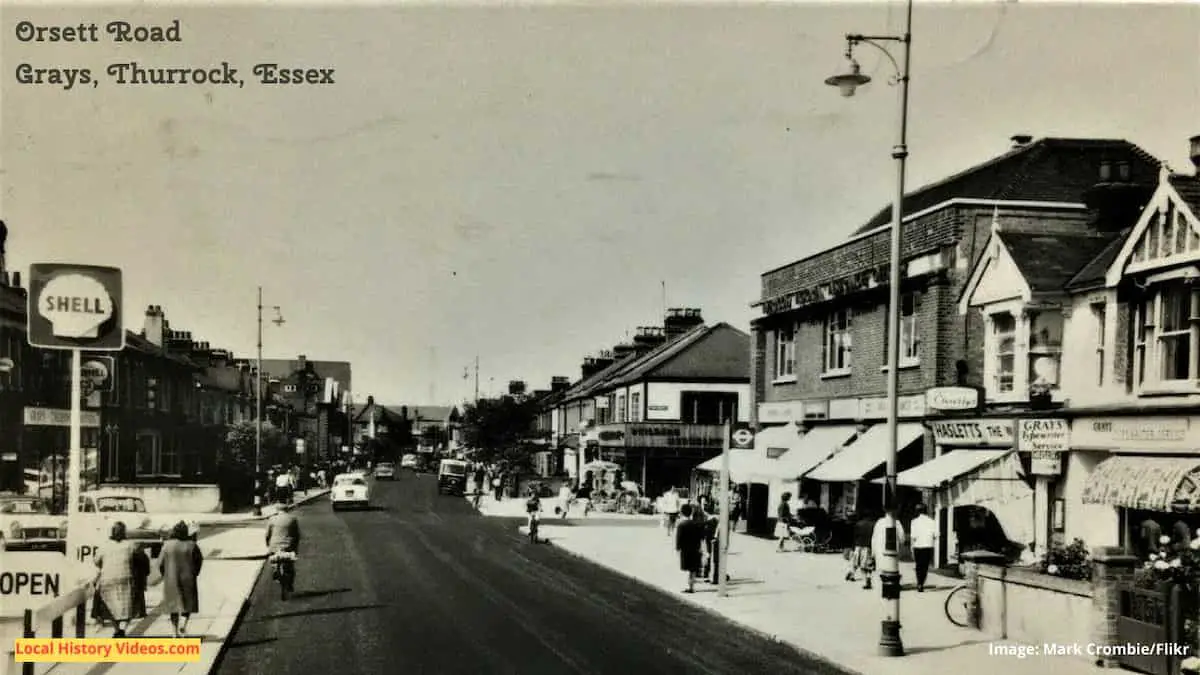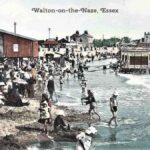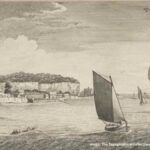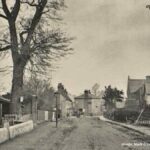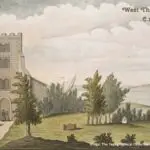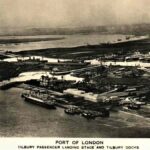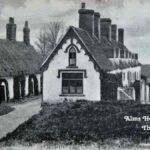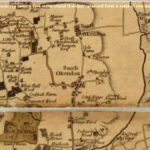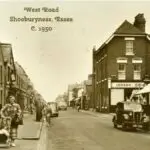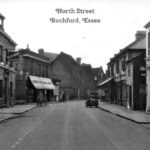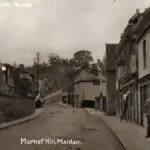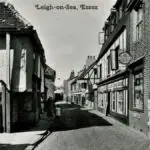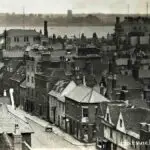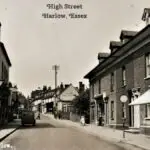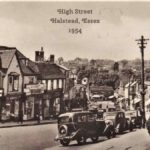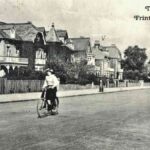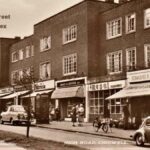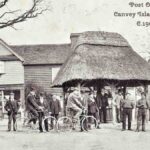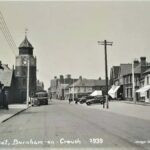Glimpse the past through old images of Grays, Essex, part of the unitary authority of Thurrock.
1960s Carnival
Processing down Greys High Street, the 1960s Carnvial passed many buildings which were later demolished for the shopping centre.
We see people preparing a float, enacting a scene from Sweeney Todd, the Carnival Queen and her court, and the band beginning to march.
At the Edgar J. Jones shop, several generations of the family and their dog have clambered out of the upstairs window to sit on top of the shop’s bay window, for a better view of the carnival.
It’s a great little film which captured hundreds of people and many, many businesses and homes at a time when few people made home recordings.
Grays Thurrock Carnival 1960’s Home Movie Cine Film – Dave Eldergill on YouTube
1970s Chimney Demolition
In the 1970s, development of the new Dolphin Industrial Estate was planned for a brownfield site. To make the land ready for construction, and old industrial chimney had to be demolished.
This short film includes a diagram of the new Dolphin Industrial Estate, preparations for the demolition works, some of the men working for Thos W. Ward Ltd, local people who came to watch the chimney demolition, and the huge dust clouds created when the chimney fell to the ground.
Chimney Demolition in Grays Essex 1970’s Super 8 Cine Film – Dave Eldergill on YouTube
Historic Book
Extract from: Stifford and Its Neighbourhood, Past and Present. Printed for Private Circulation, by William Palin
Published in 1871
Pages 33 – 36
GRAYS THURROCK .
That portion of the Thurrocks now known as Grays Thurrock , is recorded
in ‘ Domesday ‘ as having been two manors , one belonging to Harold , the
other to Almar .
Harold’s was a great lordship , estimated at 13 hides of land , valued at
£ 12 annually , and after the Conquest fell to the possession of Robert , Count
of Eu , cousin to King William . Almar’s manor was measured at 3 hides
and 42 acres , valued at £ 6 . Nine socmen were attached to this manor , who
held between them 2 hides of land ; this estate became the property of
William Peverel , of Nottingham , the natural son of the Conqueror .
These both were very great Barons , whose chief estates lay in distant
counties . They both held their Thurrock manors in demesne , that is , in
their own hands , and the produce would be stored up for their use .
To Harold’s manor were attached 7 houses in London , one of which we
may presume became the town residence of the Count of Eu , and to it
would be easily conveyed by water , the produce of the manor at Thurrock .
It was the only property that the Count of Eu possessed in Essex ; and in
those days , when rents were paid in kind , and money was scarce , such an
accessible country manor would be extremely convenient ; independent of
the power of indulging there , among the Essex forests , in the Norman pas
sion for the chase , this manor contained in King Edward the Confessor’s
time 6 carucates of arable on the demesne , and 10 amongst the tenants
[ hominum ] , 12 villeins , 16 bordars , and 16 slaves . But under the Count of
Eu there were only 5 carucates of arable on the demesne , and 13 amongst
the tenants , 17 villeins , 45 bordars , and only 8 slaves . The diminished
number of slaves amongst the Norman lords is almost universally observ
able . From some cause downright slavery must have been inconsistent with
their habits and modes of tenure . On this lordship of Thurrock there was
woodland for 200 hogs , pasture for 500 sheep , 40 acres of meadow , 2
fisheries , 5 cows , 3 farm – horses , [ runcini ] , 16 hogs , 550 sheep . The value
formerly estimated at £ 12 , but under the Count of Eu at £ 30. * The in
crease of population is worthy of remark . Such facts as these prove that
the change from the Saxon to the Norman rule was not always for the
worse .
Robert , Count of Eu , was one of the Norman Barons summoned by Wil
liam , then only Duke of Normandy , to attend the famous Council at Lille
bonne . He afterwards accompanied him in his invasion of England .
where the Conqueror intrusted to him the enstody of the Castle of Hastings ;
he also bestowed on him and his son William d’Ea great estates in va
rious counties . Through the great obscurity of past ages we have historic
glimpses of Robert , Count of Eu . In 1070 he was one of the Barons sent
to check the Danish invasion of Yorkshire . During King William’s subse
quent absence in Normandy , Count Robert was left in England , in high
authority . After the death of the Conqueror , he espoused the side of
William Rufus , in opposition to that of Robert Court – hose . Four genera
tions passed , and then the last male heir of these ancient Counts of Eu died ,
leaving an only daughter and heiress , Alice , the wife of a Frenchman , Ralph
de Lusignan , or De Ysondun . She lived during the reigns of Richard Cour
de Lion and John ; on the loss of Normandy by that king , she was , like
many others , obliged to decide to which monarch she would give her alle
giance . Her choice was in favour of Philip Augustus , the French king ,
with whom in 1219 she as a widow made a treaty by deed , respecting the
restoration of her Comté of Eu , which he had seized . Her descendants ,
being the Counts of Eu of the second race , became henceforth decidedly
French , and the English estates escheated , as a matter of course , to the
Crown . Morant overlooked these facts when he says , speaking of Thur
rock , ‘ This manor becoming vested in the Crown [ by what means we do
not learn ] , King Richard I. in 1194 granted it to Henry de Gray . ‘
The probability is , that Ralph de Lusignan , the husband of the Countess
Alice , being a Frenchman , not a Norman , had in some way fallen under the
displeasure of King Richard , during the wars of that monarch with Philip
Augustus , King of France .
We must now return to the second and smaller Manor , originally pos
sessed by Almar the Saxon , and afterwards by William Peverel . The entry
respecting it in ‘ Domesday ‘ is translated as follows : – **
Turroc is held by William [ Peverel ] in demesne ; it was held by Almar
in King Edward’s time , as a Manor , and as 3 hides with 42 acres . Then
2 Villeins , now 3. Then 21 Bordars , now 18. Always 2 slaves , and
2 carucates of arable in the demesne . Then 4 carucates of arable among
the tenants , now 5. Pasture for 100 sheep . Always a fishery . Then
2 villeins [ query cattle ] , 58 sheep , 1 – cart – horse : now 5 cows , 4 calves , 85
sheep , 8 hogs . Then it was worth £ 6 , and the same when he took posses
sion , now £ 12 and an ounce of gold . To this Manor belonged 9 socmen
in King Edward’s time holding 3 hides ; now there are 5 , holding a hide
and a half . And Gilbert , one of the Bishop of Bayeux’s vassals , holds a
hide and a half less 10 acres ; and the Hundred does not know by what
means . Twenty acres are also held by Anschetill , one of the Bishop of
London’s vassals , which did belong to this Manor in King Edward’s time ,
as to this also , the Hundred knows not . “
William Peverel , of Nottingham , the capital Lord of this Manor , was son
of the beautiful Ingelrica , daughter of Ingelric the Saxon ; and , although he
bore his name , was only stepson of Ralph Peverel , the Essex baron , the
husband of his mother . William Peverel , of Notts , so called to distinguish
him from his half – brother , William Peverel , of Dover , was greatly trusted
by his lord and father , King William the Conqueror . He made him
Castellan of Nottingham Castle , and endowed him with vast estates in the
midland counties . In Derbyshire , the remains of the castle of Peverel of
the Peak recall his memory . In Essex he held only two manors , this at
Thurrock , and another at Thorington [ Toringdunum ] . William , his son
and heir , was accused of having poisoned Ralph , Earl of Chester , towards
the close of Stephen’s reign . His Honour of Nottingham was consequently
forfeited , and he fled , his disappearance giving rise to romantic stories
respecting him . He left one sole daughter and heiress , Margaret , wife of
William Ferrars , third Earl of Derby . Their marriage took place at Canter
bury in 1163 , Thomas à Becket , the Archbishop , being the officiating priest . *
Margaret Peverel inherited the remainder of her father’s estates , or perhaps
had them settled as her marriage portion before the forfeiture . She is said
to have lived till 1247 ; it is possible that such may have been the case , as
in those ages marriages were contracted in childhood . Earl William Ferrars
gave by charter , sans date , the church of Thurrock [ Turrok ] , with all its
rights and appurtenances , to the Knights of St. John of Jerusalem , for the
health of his own soul , that of his wife , of his ancestors , and his heirs . This
charter is given in the Monasticon.’t The manor of Thurrock was long
in the possession of the Ferrars family , and was settled , together with their
other Essex estates , by William de Ferrars , seventh Earl of Derby , in
1252 , upon his younger son , William de Ferrars , of Groby , to hold of him
by the service of five knights ‘ fees . On the death of William , sixth
Earl of Ferrars of Groby , in 1414 , his granddaughter and heiress , Elizabeth ,
carried these Essex estates in franc – marriage to her husband , Sir Edward
Grey ; and what rights the Ferrars family retained in Thurrock , seem to
have gone with them to the Greys . * We thus find , both the manors into
which Thurrock was divided became the property of the members of the
Grey family . It may well bear the name of Grays Thurrock ; and here is a
very suitable place to mention some particulars respecting the origin of that
illustrious family , of which Grays Thurrock , in Essex , certainly appears to
have been the English cradle ; like many other cradles , very humble as
compared with the after fortunes of its occupant and his descendants .
French genealogists assert that the name of this family is derived from
the parish of Gray , in Normandy . They consider that the descent of the
De Greys or Grays from the lords of Croy , in Picardy , as assigned to them
by Edmundson and some other English genealogists , is both fabulous and
ridiculous . + Dugdale , however , is an exception ; he commences his pedi
gree of the Greys with Henry de Gray , to whom Richard Coeur de Lion
gave the manor in Thurrock . We , however , will go further back , to An
schitillus de Grai , who is recorded in Domesday ‘ as holding seven manors
in Oxfordshire , of the barony [ then escheated ] of William Fitz Osborn , Earl
of Hereford . Contemporary with Anschitillus , notices of the Gray family
occur in Normandy , in which duchy Gray is a village on the shore of the
English Channel , in the modern department of Calvados . In 1082 , Gisla ,
daughter of Turstin , gave all her land in Gray and Dounville to the Abbey
of the Holy Trinity at Caen ; ** her nephew , Turstin , to whom the fief belonged ,
[ cujus feodum erat ] consenting to the same . The authors of the ‘ Re
cherches sur le Domesday ‘ do not hesitate to set down Anschitillus de Grai ,
of Oxfordshire , as the younger brother of Turstin , feudal lord of Grai .
Whether in England or in Normany , the links in the family chain seem to
be entangled , if not entirely missing , until the end of the twelfth century .
Then , in 1168 , Henry and William de Gray appear as benefactors to the
Abbey of Longues.tt Also in a charter , sans date , William and Henry de
Gray , son of Serlon de Gray , acknowledged that their elder brother , Richard
De Gray , had given the advowson of Tracy to the Abbey of Cericy . In
1184 William de Gray owed 16s . to the Normandy Exchequer , ‡‡ and soon
after William de Gray confirmed to the Abbey of Cericy the tithes of all
his land at Litry .
More about Essex
- Old Images of Essex, England
- Old Images of West Hangingfield, Essex
- Old Images of Purfleet (Purfleet-on-Thames), Essex
- Old Images of Wickford, Essex
- Old Images of West Thurrock, Essex
- Old Images of Walton-on-the-Naze, Essex
- Old Images of Tilbury, Essex
- Old Images of Thaxted, Essex
- Old Images of South Ockenden, Essex
- Old Images of Shoeburyness, Essex
- Old Images of Rochford, Essex
- Old Images of Maldon, Essex
- Old Images of Leigh-on-Sea, Essex
- Old Images of Harwich, Essex
- Old Images of Harlow, Essex
- Old Images of Halstead, Essex
- Old Images of Frinton-on-Sea, Essex
- Old Images of Chigwell, Essex
- Old Images of Canvey Island, Essex
- Old Images of Burnham-on-Crouch, Essex

